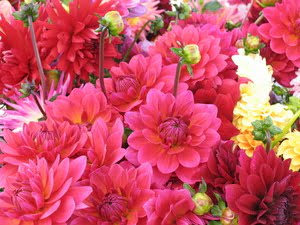Spring Flowers: Gladiolus
If you live in cold climates of the U.S. it’s time to plant gladiolus’ corms (gladiolus bulb). If you live elsewhere in the United States, and don’t already have gladiolus in your garden, start digging. Some gardeners recommend planting gladiolus as annuals. Leaving them in the ground will produce larger, healthier blooms each year.
Gladiolus are easy to grow. I tend to have a brown thumb, but gladiolus were able to survive my brown thumb. Regardless of your gardening experience they will survive your gardening. The beautiful tall flowers add sparks of color to the garden. Gladiolus are available in white, pink, purple, red, yellow, green and even multi-colored blooms.
I was taught to plant gladioli in groups. Clusters create the best look in a garden. The plant should be planted in full sunlight. Direct sunlight allows them to grow hardy and sturdy. The soil around your gladiolus should drain well. If the soil is wet, raise the bed using pebbles or stones, or recycle Styrofoam peanuts, to create a bed that will drain.
Gladiolus may also be used in a garden border. I prefer to use their tall, spike-like blossoms to create a variety of garden clusters. My grandmother taught me to plant gladiolus from May through June to keep gladiolus blooming all summer long. The garden stays fresh as new sprigs of gladiolus bloom until the end of summer.
Spring Flowers: Dahlias
Making a selection of Dahlias for your garden may not be an easy process. There are literally thousands of varieties of Dahlias from which to choose. It seems like the hybrid selection grows every year.
I select my favorite colors and sizes based on where I want to plant them in the garden. Smaller varieties are as small as twelve inches. Large Dahlias add drama to your garden and can grow from six to eight feet tall with huge, beautiful blossoms.
Dahlia bulbs need to be planted in soil that drains well. As with your gladiolus, build up your garden to allow dahlia bulbs to thrive. Use small stones, bone meal, or recycled Styrofoam in the soil mixture where you plant you dahlias. Dahlias are easy to grow, and I know some gardeners who seed their own each year for variety. Bulbs or seeded Dahlias work well. Bulbs do have to be dug up and stored.
Do not plant dahlias in direct sunlight.
Once dahlias bloom they require a lot of water. As they grow stake larger varieties. My grandmother taught me to stake flowers using nylons which will stretch as they grow. Strings or wires may cut the stem.
If you want to create clusters of dahlias trim back new growth with garden sheers when the plant is small. If you have chosen tall varieties and want to create a large bloom, trim off all offshoots of the plant. Allow all of the water and plant food to work directly on growing one large bulb.
Plant large dahlias in the back of your garden, or near the sides, out of direct sunlight, to add interest. If you choose to cluster smaller dahlias grouping them in front of gladiolus is a nice plan.
Spring Flowers: Lilies
One of the third most popular spring flowers is the lily. Lilies are another plant that is easy to grow, or they wouldn’t survive in my garden. I enjoy planting lilies to add color and larger clusters of petaled flowers to the garden.
Lilies come in a variety of blooming flowers including early, mid-season, and late blooming. Selecting a variety allows you to have blooms throughout your garden season. You may also spread the time of your plantings throughout the gardening season.
One of the pleasures of lilies is their brilliant colors and enchanting fragrance. Lilies are a great choice to add bulk to your garden’s span. Easter lilies are more popular as flowering pot plants, but can also be used to add a more neutral color to your garden to make exotic colors pop.
Clusters of lilies add a professional look to your garden. Plant them in full sunlight and well draining soil for best results. Some lilies grow better in shade, be sure to check the growing directions.




